SOLD
19th Century Antique Natural Indigo and Iron-mordant Dyed Hand Woven Pure French Linen Made Maquignon Coat
今なお世界のリネン原料のフラックス(亜麻)生産の70%を生み出し続けるフランスは、文字通りのリネン大国です。栽培には温帯から熱帯の気候を必要とするため、綿の栽培が難しいフランスの気候に適した亜麻は、衣類のみならずシーツなどの寝具や寝間着などのホームリネンから、テーブルクロスやナプキンなどのテーブルリネンにも使われフランス人にとっては綿以上に生活に密着した最も身近な繊維です。
France is literally a linen powerhouse, as it still produces 70% of the world’s linen flux (flax). Flax is used not only for clothing, but also for home linens such as sheets and bedclothes, table linens such as tablecloths and napkins, and is the most familiar fiber to French people, more closely related to their daily lives than cotton. It is the most familiar fiber to the French people, more closely related to their daily lives than cotton.
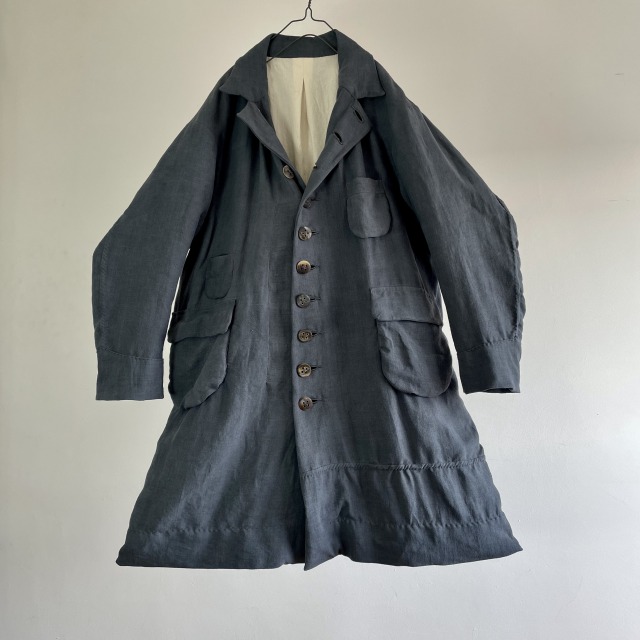
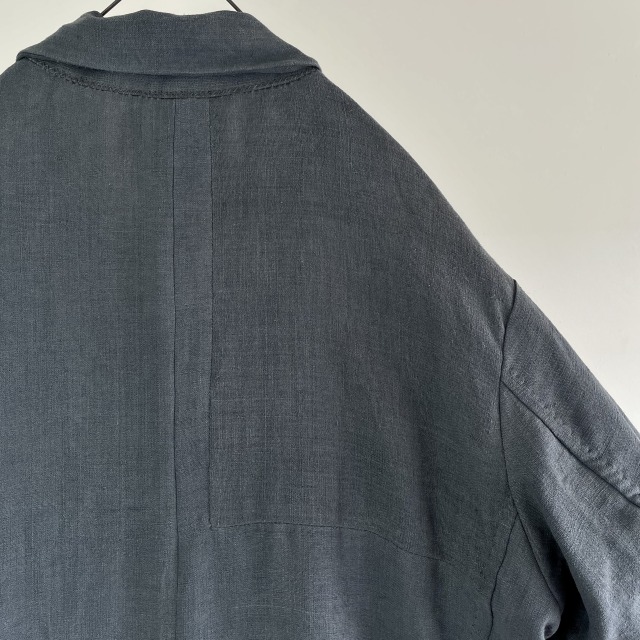
近年では中国などの紡績技術の発展により、原料栽培以外の工程(特に潤紡よる紡糸はほとんど中国)はフランス以外で行われ、リネンを糸にする紡績工程は国外がほとんどとなりました。しかし、この生地が作られた100年以上も前の時代では、フランス国内で栽培、紡績、製織された真正のフレンチリネンと言える生地が作られていました。
In recent years, due to the development of spinning technology in China and other countries, most of the processes other than the cultivation of raw materials (especially the spinning by moisture spinning in China) are done outside of France, and the spinning process to turn linen into yarn is mostly done outside of France. However, more than 100 years ago, when this fabric was made, there were fabrics grown, spun, and woven in France that could be called genuine French linen.
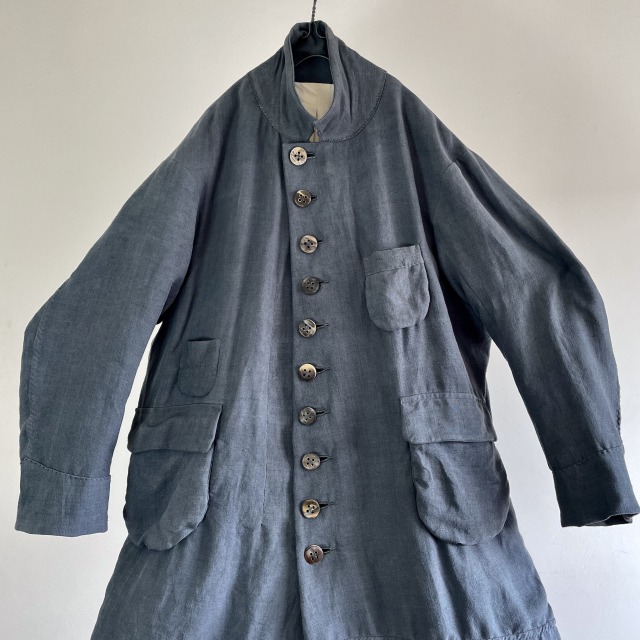
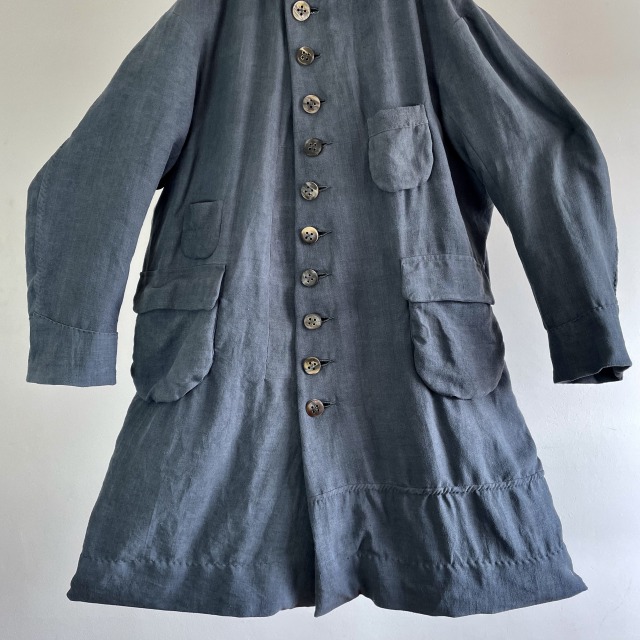
19世紀末頃に、フランスで栽培し、繊維として加工され、糸として紡績され、手動織機で織られたリネンのアンティーク生地を使ったワークコートです。
This work coat is made of antique linen fabric that was grown, processed as fiber, spun into yarn, and woven on a manual loom in France around the end of the 19th century.
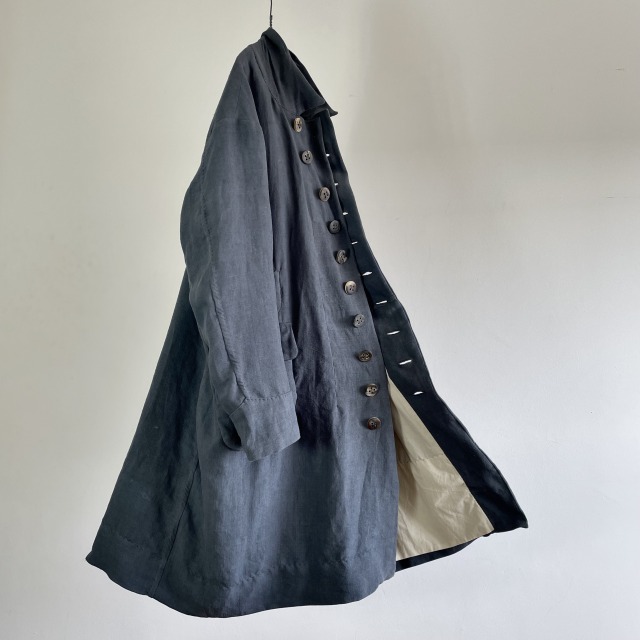
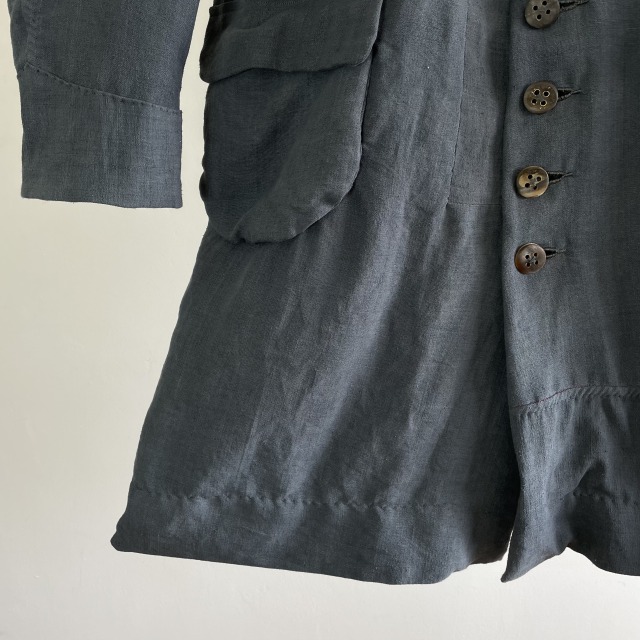
その生地を農民などがおそらく自分達で手染めしたのでは無いかと思われる、素朴なインディゴ染にさらに南フランス地方の染色技法の鉄媒染を行なった深い色合い
The fabric was dyed by hand, probably by farmers themselves, with a simple indigo dyeing technique and a deep color made with iron mordant, a dyeing technique from the south of France.
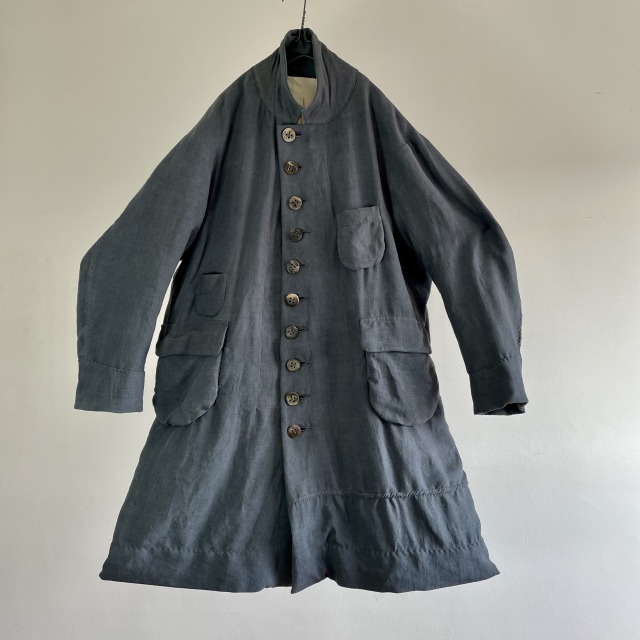
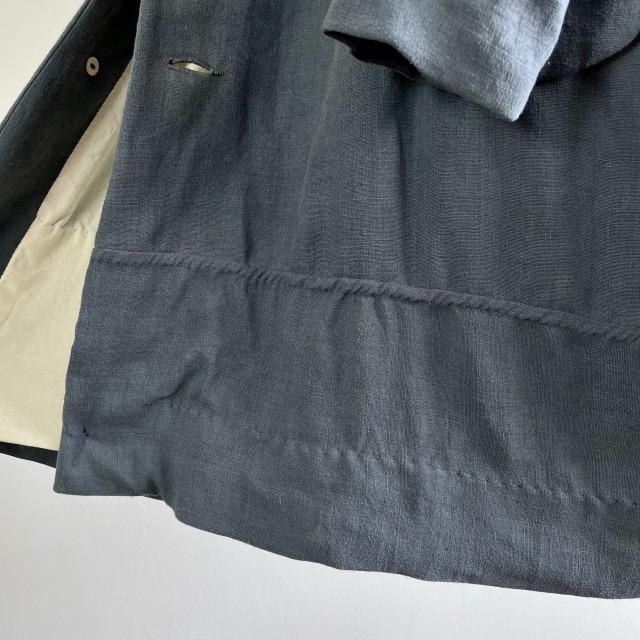
インディゴ染は当時は、今のようなファッションからの要求とは無縁の生活に根差した存在。汚れ隠し、虫除けといった実質的な必要に対して、火にかけられる大きな釜などの特別な設備がなくても、家にある桶を使って常温で染める事が出来、小規模な染色にも適した便利な手法だったインディゴ染め。
At that time, indigo dyeing was a way of life that had nothing to do with the demands of fashion as we know it today. Indigo dyeing was a convenient method that was suitable for small-scale dyeing, as it could be done at room temperature using a tub at home, without special equipment such as a large pot that could be set on fire, for practical needs such as hiding stains and repelling insects.
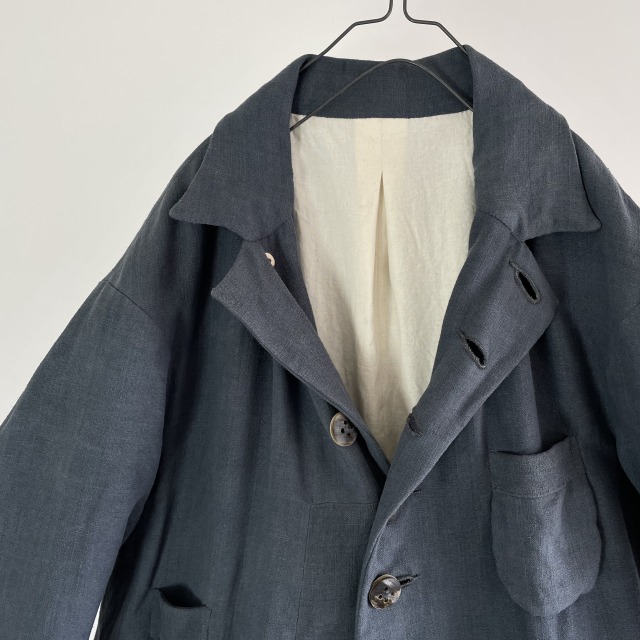
ヨーロッパのインディゴ染色は、15世紀頃まではウォードという植物による独自の藍染め方法がありました。その後バスコ・ダ・ガマのインド航路の開拓以来、インド藍がインドから輸入されるようになると、値段や染色性、発色の良さからウォードは廃れ、インド藍に置き換えられてしまいました。
Indigo dyeing in Europe had its own indigo dyeing method using a plant called woad until around the 15th century. Later, when indigo was imported from India after Vasco da Gama opened the Indian trade route, woad became obsolete due to its price, dyeability, and coloration, and was replaced by indigo.
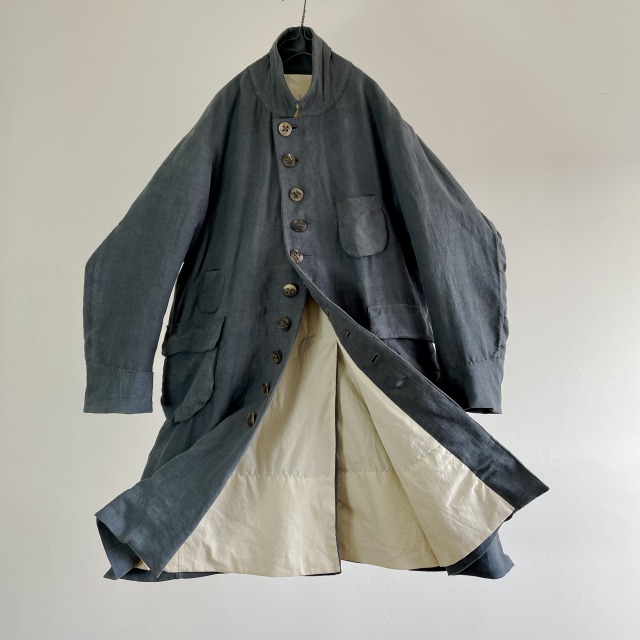
その後普及していく合成インディゴの開発は、1900年初頭以降。この生地が作られた19世紀末頃は、まだ天然のインド藍による藍染めリネンが作られていた時代と考えられます。
The development of synthetic indigo, which became widespread after that, was after the early 1900s. It is thought that indigo-dyed linen using natural Indian indigo was still being produced around the end of the 19th century when this fabric was made.
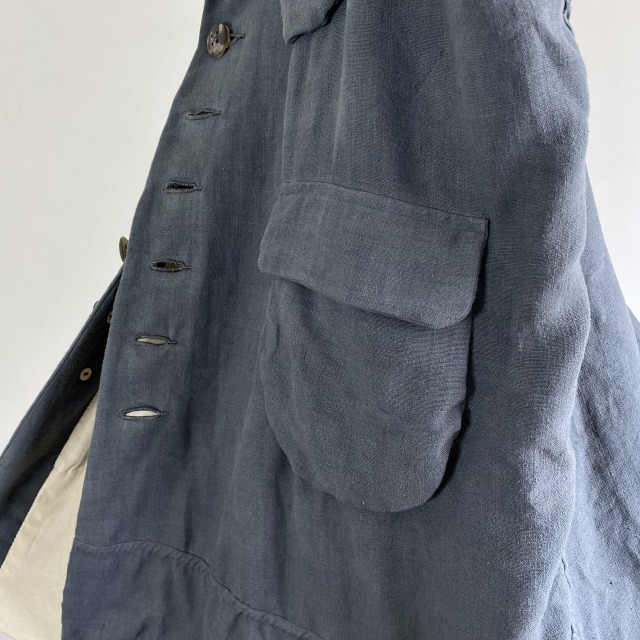
そのインディゴ染の色落ちを抑え、堅牢度をたかるための鉄媒染。グレーがかった深く藍色と手染めの素朴な風合いが生地の存在感を際立たせています。
Iron mordant dyeing is used to suppress the color fading of the indigo dyeing and to increase the colorfastness. The deep indigo color with a hint of gray and the rustic texture of hand-dyeing make the fabric stand out.
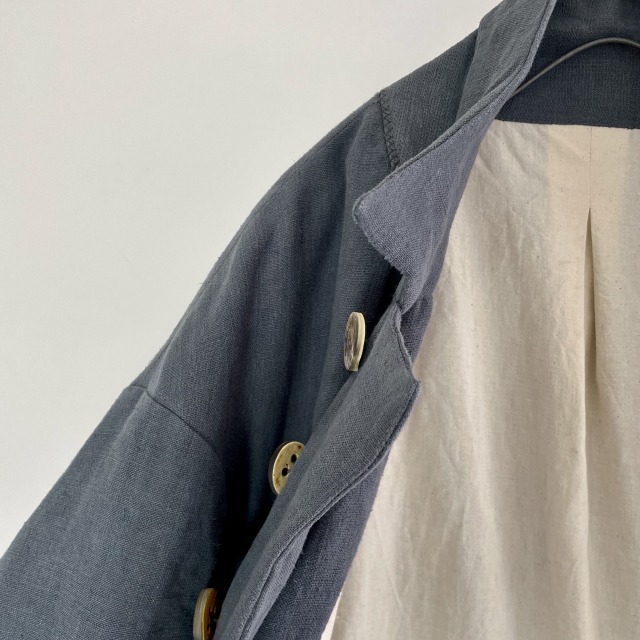
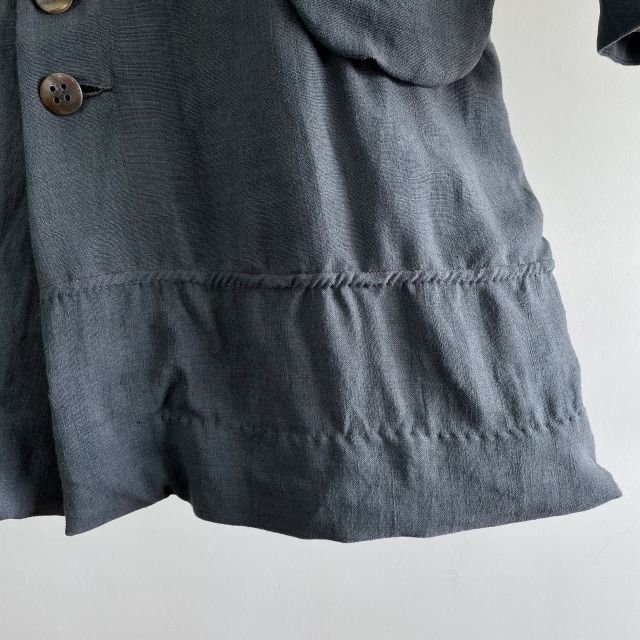
昔のフランスのワークウェアの良さは、何と言ってもテーラーワークを基本にしたパターンと縫製が作り出す立体的で曲線的なデザインと、雰囲気溢れる生地の表情。その流れを尊重した作り。
The beauty of old French workwear is the three-dimensional and curvy design created by tailor-work based patterns and sewing, and the expression of fabrics full of atmosphere. This is a production that respects this trend.
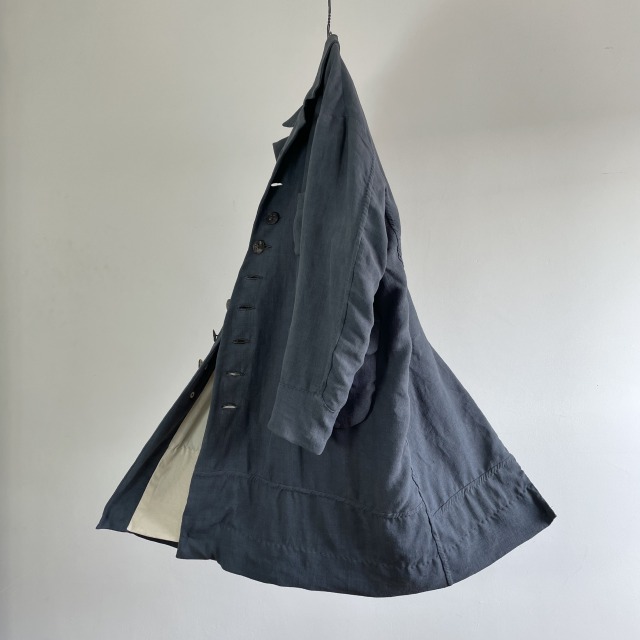
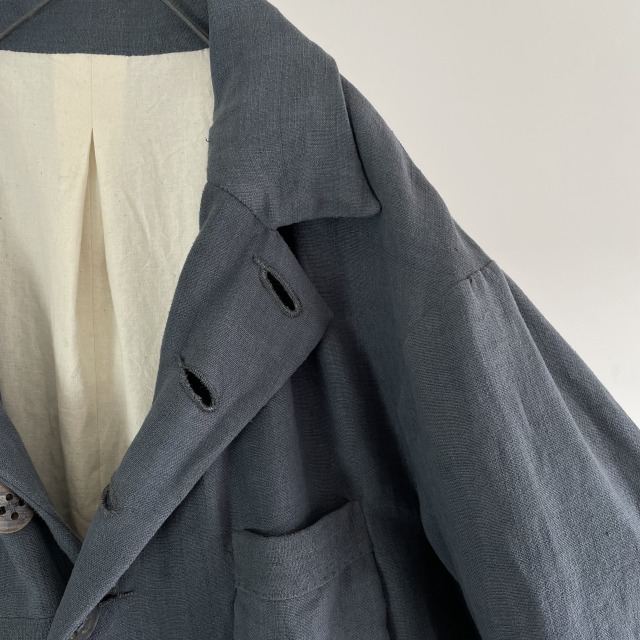
独自のスタイルを持ち現代に通用するモダンさを持ち、アメリカやイギリスのように、コントラストをつけた太く頑丈なステッチが、2重3重に入るタフで無骨なワークウェアとは全くの別世界の代物です。
It has its own style and is modern enough to be used today. It is a completely different world from the tough and rugged workwear with contrasting thick and sturdy stitching that is double or triple layered, as in the United States and England.
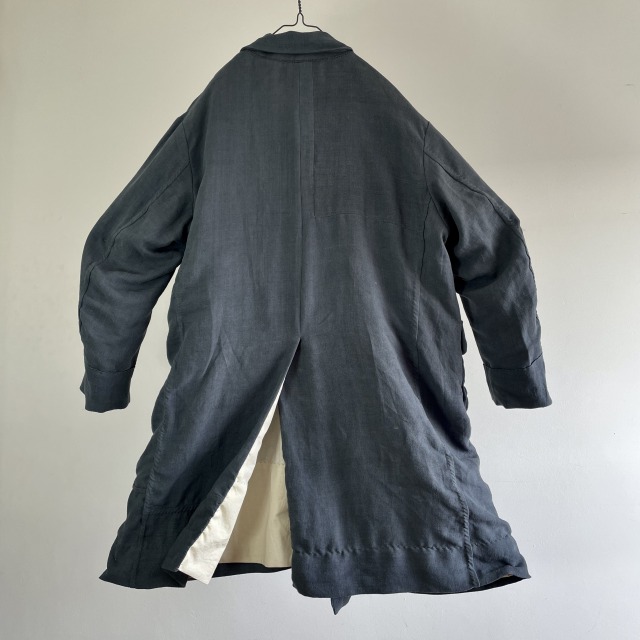
体のラインに沿う肩傾斜や テーラーのような袖付けと、腕の稼働の必要性に合わせて曲線を描きだす美しい袖の作り。シームやカフスのハンドステッチが作るミニマルなアクセント。
The slope of the shoulders follows the lines of the body, the sleeves are tailored, and the sleeves are beautifully made to curve to meet the needs of the arm’s movement. Minimalist accents created by hand stitching on the seams and cuffs.
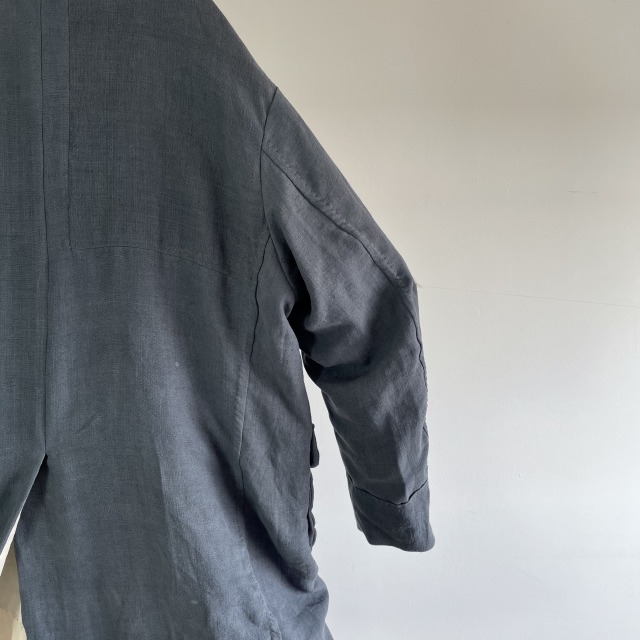
深く切られたベントは、たっぷりとした蹴回し分量をさらに表情豊かに彩ります。
Deeply cut vents add more expressive color to the generous amount of hemcircumference.
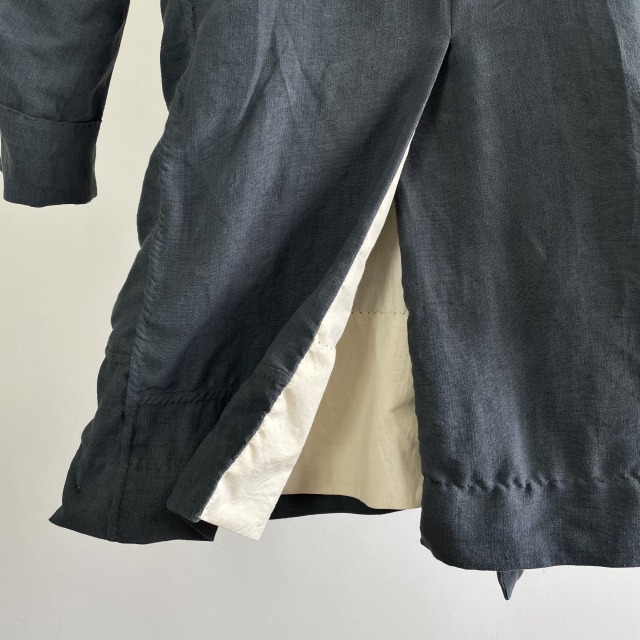
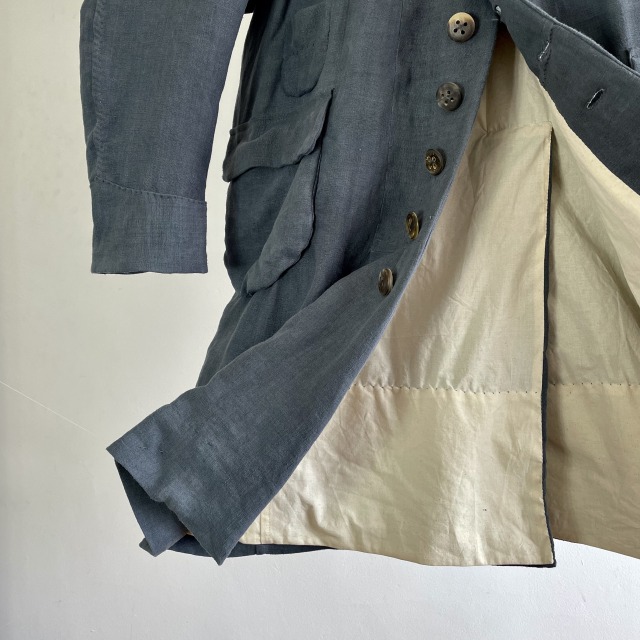
ハンドステッチでのライニング。手の温もりではなくストイックさを伝える不揃いなステッチ、縫い皺の表情や生地のコントラストが乾いた奥行きを作り出します。
Lining with hand stitching. Uneven stitching that conveys stoicism instead of hand warmth, the expression of stitch wrinkles and fabric contrast create a dry depth.
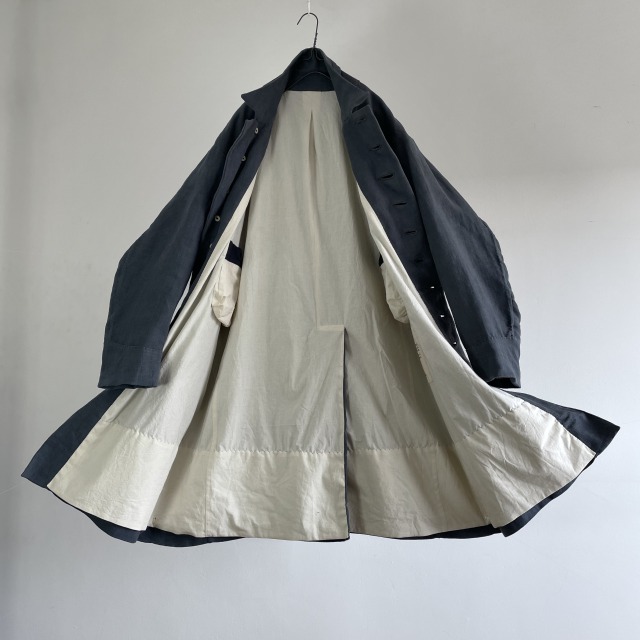
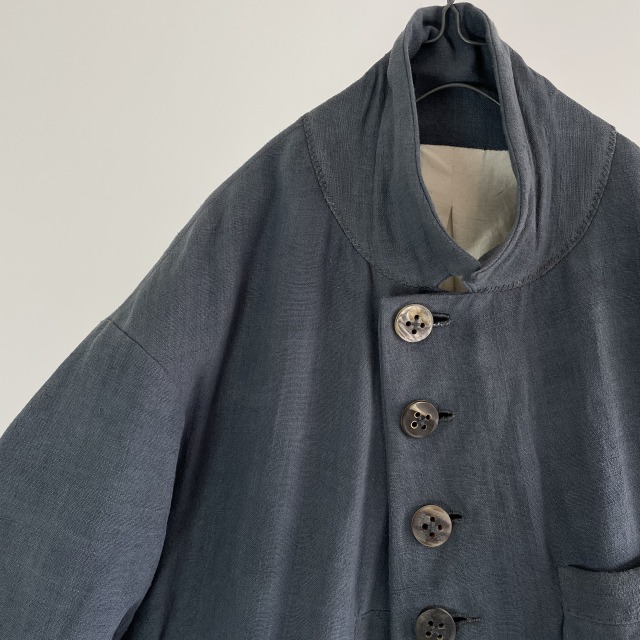
長い時間を経てきた生地に残る時間の痕跡は、意図して作れないものです。様々な要素が積み重なった言葉のいらない存在感。
The traces of time that remain in fabrics that have gone through a long period of time cannot be created by intention.
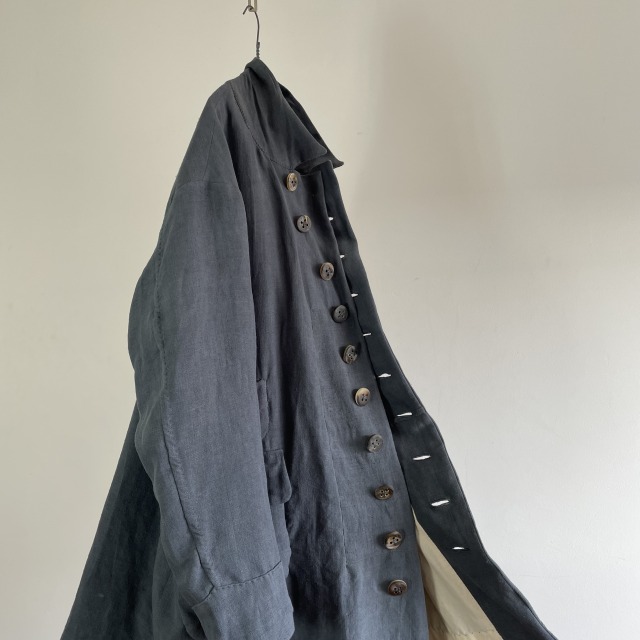
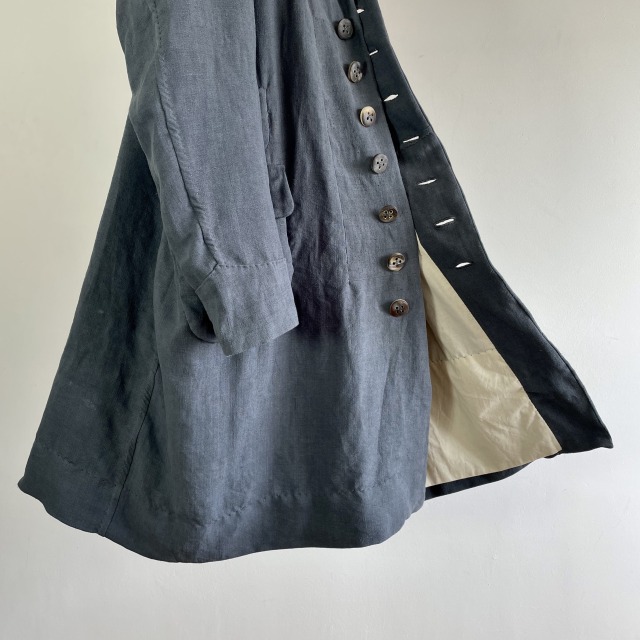
ライニングの手縫いのブラインドステッチ。ミシンで縫えば数分の仕事に、その十数倍の時間をかけたことの意味は、きっとあるはず。
Blind stitching by hand to sew the linings together. It must be meaningful that we spent more than ten times as much time on a job that would take only a few minutes if sewn with a sewing machine.
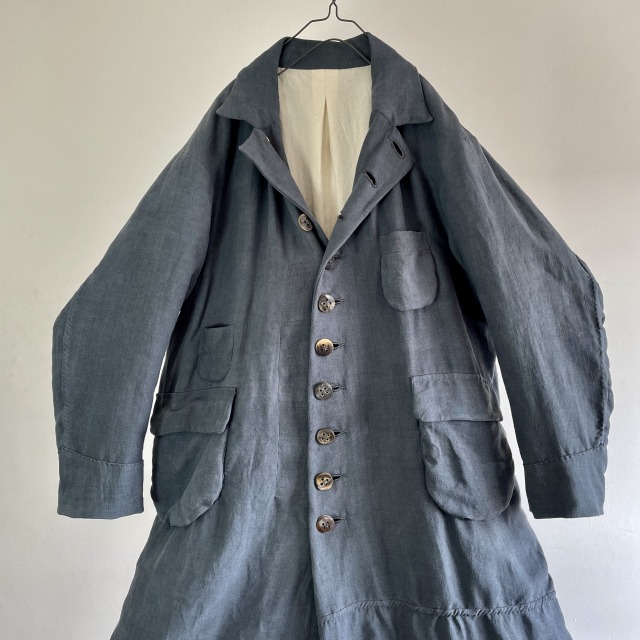
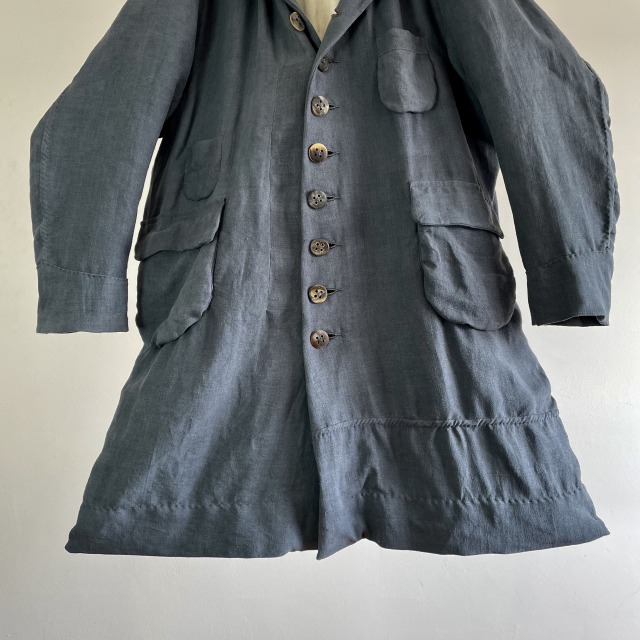
端を浮かせて、手でブラインドステッチでつけた丸みのあるポケット。
Rounded pockets with floating edges, blind-stitched by hand.
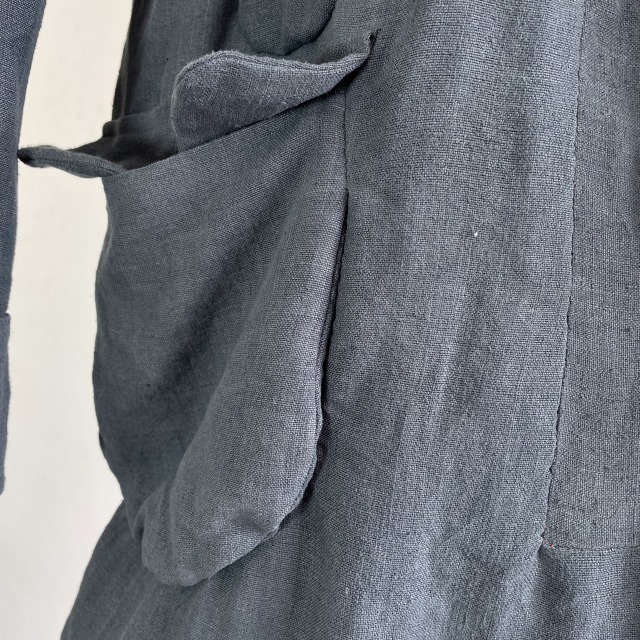
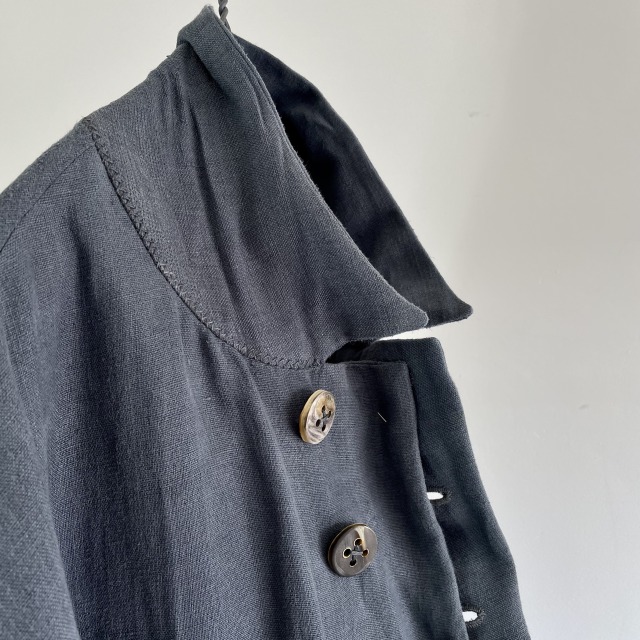
アンティークのダマスク織のポケット口とハンドステッチが効いたソフトなフォルムの内ポケット。
Antique damask weave on the pocket opening of the softly shaped inner pocket with hand stitching.
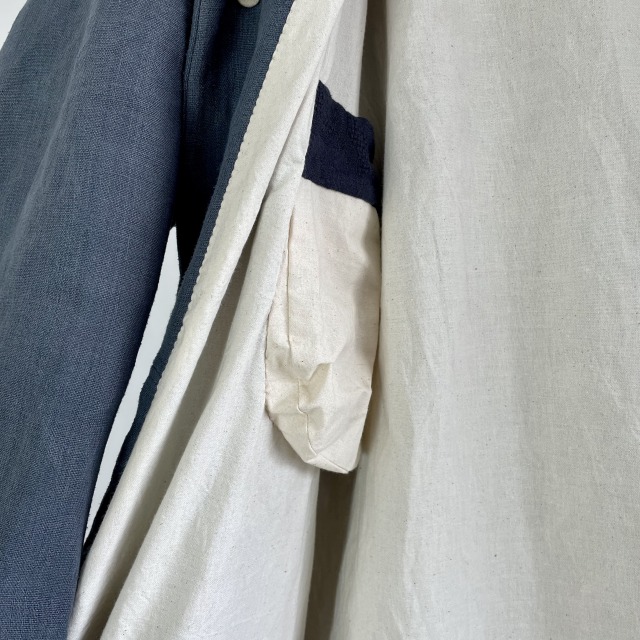
ボタンは英国の1950-1960年代のVintageのデッドストックです。通常に見られる角のボタンのほとんどは水牛の角から作られているもので、主としてアジア圏の水牛の角をアジア圏で加工したものです。このボタンは、英国の有名紳士服ブランドの注文により特別に作られた、英国の牛(ヘレフォードやアバディーンアンガス)の角を使って英国で作られたものです。
The buttons are British 1950s-1960s vintage dead stock. Most horn buttons normally found are made from buffalo horn, mainly from Asian buffalo horn, processed in Asia. This button was made in England from the horn of a British cow (Hereford or Aberdeen Angus), specially made to order for a famous British menswear brand.
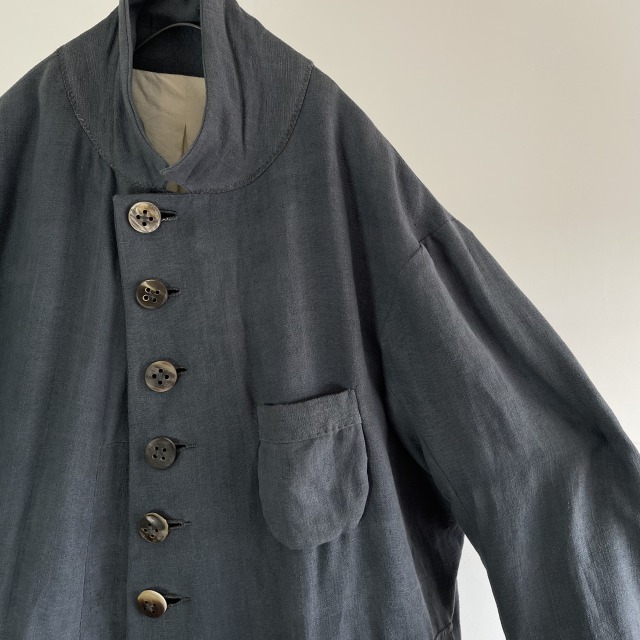
4-6mmという厚み、裏側の皮付き仕上げ、ブラウン、ブラック、乳白、透け感のあるベージュと濁ったベージュなどが自然に入り混じった角の色合い、27mmという大きさ、モダンな印象をも感じさせる、間隔が広く大きな穴の4つのボタン穴、丸く切り出した形を粗く削っただけで素のままの表情を活かした風合い、どこを取っても迫力と良さしかない60年以上も前の貴重で珍しい逸品のボタンです。
The thickness of the button is 4-6mm, the leather finish on the back side, the color of the corners is a natural mixture of brown, black, milky white, translucent beige and muddy beige, the size of the button is 27mm, the four button holes are widely spaced and large, giving a modern impression, and the shape was cut out in a round shape and roughly shaved. It is a precious and rare gem of a button from more than 60 years ago that has nothing but power and goodness no matter where you take it.
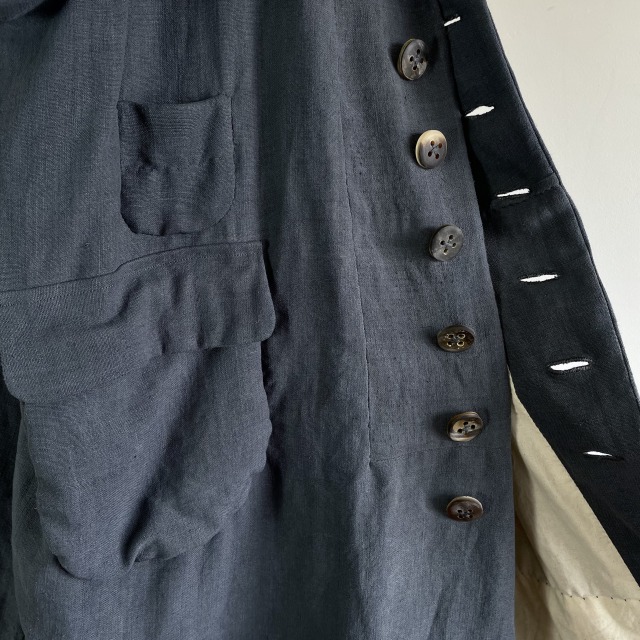
カフスもハンドステッチ。ボタンホールも全て手縫いです
Cuffs are also hand-stitched. Buttonholes are also all hand-stitched.
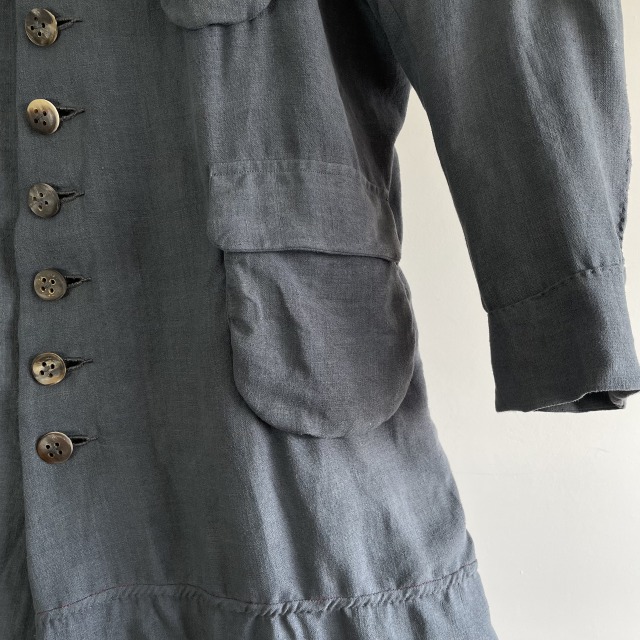
ヘムを軽くするために、止めつけずに浮かせてつけたライニングの裾。適度なボリュームを持たせるために深い見返しをつけ、ハンドステッチでアクセントを添えています。
To lighten the hem, the lining hem is floated instead of sewn. A deep turnover is added to give the right amount of volume, and hand-stitched accents are added.
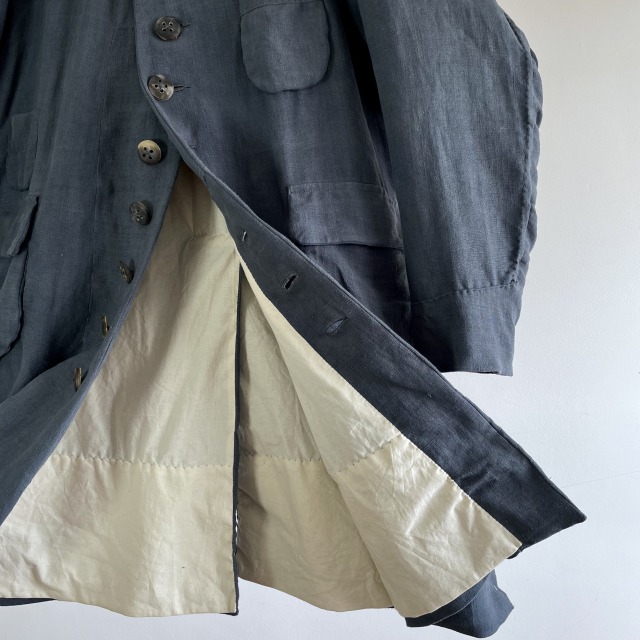
antiqueの生地と、今はもう作られなくなった仕事着のフォルム。そこに乾いた手の仕事と現代性を融合させて作り上げた、コートです。着る人の個性と存在感を際立たせる1着です。
Antique fabric and the form of work clothes that are no longer made. This coat was created by fusing the dry work of hands with modernity. It is a garment that accentuates the individuality and presence of the wearer.
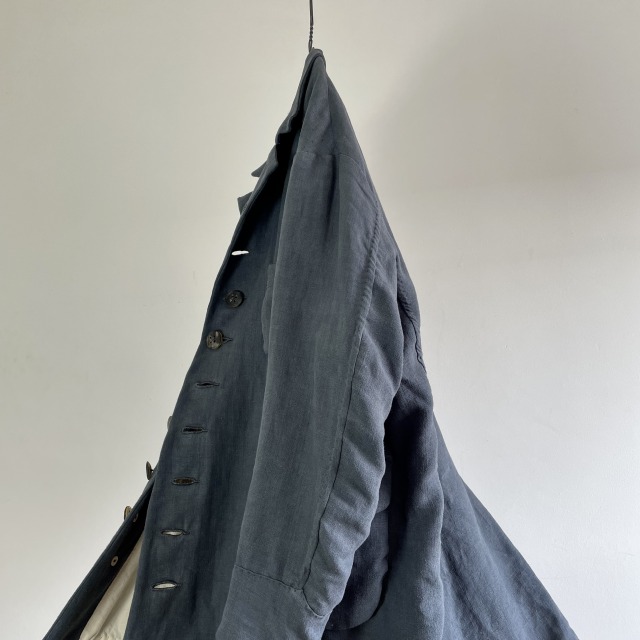
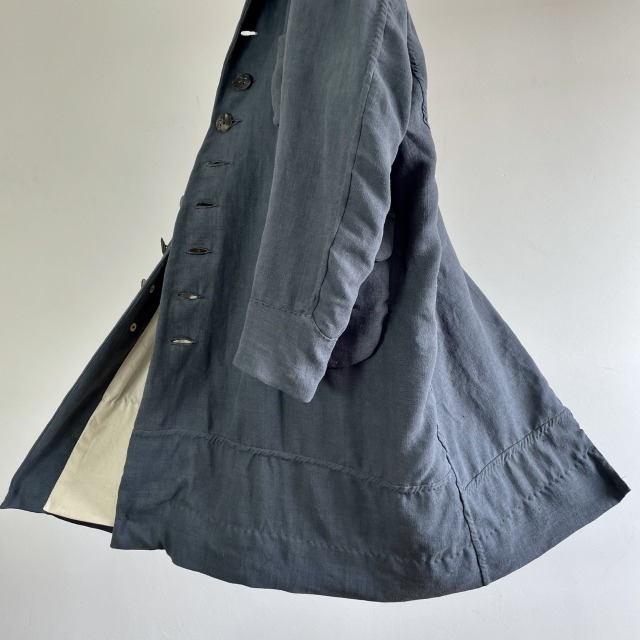
Size = △
Shoulder width = 52 cm
Bust = 65 cm (underarm)
Sleeve length = 62 cm
Length = 105 cm
Made in France/Japan
Front Fabric = Antique Natural Indigo & Iron-mordant Dyed Rustic Linen/ Linen100%
Back Fabric = Indian Rustic Cotton Broad Cloth / Cotton100%
Buttons =1950-1960 Vintage French Cow Horn Button
& Antique Fabric Covered Button
STOREへのリンク
[STANDARD By Manure Of Drawers] SOLD

